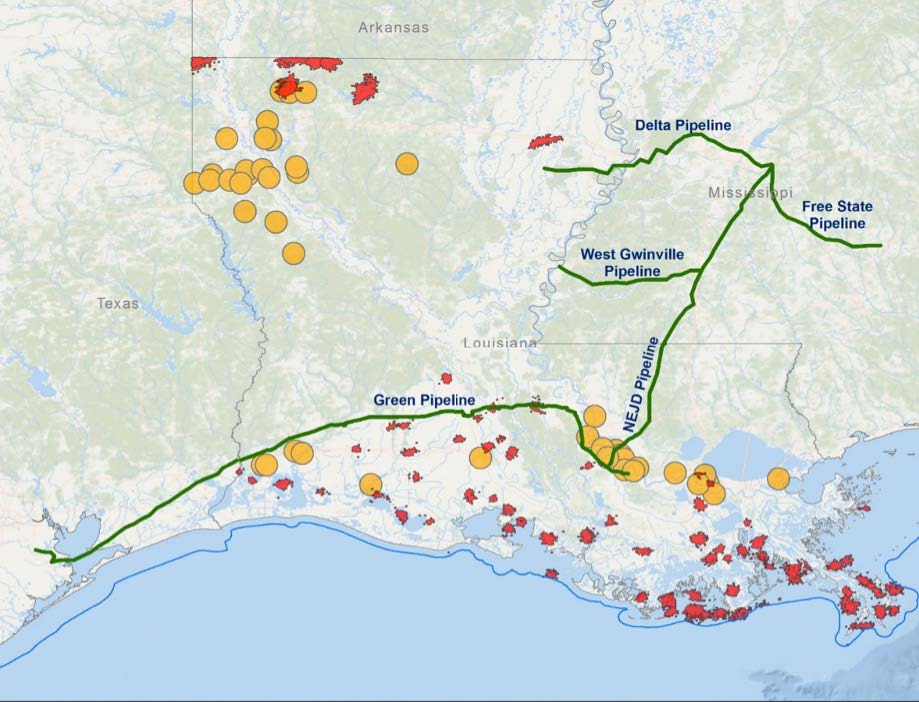The Central Gulf Coast Initiative for CO₂ Utilization and Storage Acceleration (CO₂ USA) is a market-driven undertaking to accelerate the commercialization of carbon capture, utilization, and storage (CCUS) technologies within the industrial sector. In cooperation with the U.S. Department of Energy’s (DOE) Office of Fossil Energy, the Southern States Energy Board (SSEB) is developing a roadmap and toolkit to rapidly implement industrial CCUS applications that value CO₂ as a commodity.
The Central Gulf Coast region provides an ideal setting for industrial carbon capture due to the large number of facilities that produce and vent CO₂ in relatively high concentrations. The region also has an existing CO₂ transportation network and numerous oil fields that are suitable for CO₂-enhanced oil recovery (EOR).
CO₂-EOR has been employed for over four decades to revitalize old oil fields where production has declined. The limiting factor in many areas, including the Central Gulf Coast region, is the availability of sufficient volumes of CO₂ to spur further development of oil fields suitable for CO₂-EOR. Louisiana State University (LSU) has identified many oil fields in the region that could be brought back into production with CO₂ from industrial sources.
Within the region, there are clusters of industrial sources with high-purity CO₂ that currently vent to the atmosphere. Capturing CO₂ from these sources could reduce emissions and increase output in existing oil fields that are in decline. SSEB and LSU have screened potential sources of CO₂ and directed the focus of CO₂ USA to clusters of high-purity, high-volume production. The roadmap that is under development will guide the market-driven capture of commodity CO₂ from industrial sources.
Absent any government regulations on CO₂, all future investments made to capture CO₂ will need to be financially attractive based on revenue generated from the sale of CO₂ and/or revenue generated from oil produced through CO₂-EOR.
The region has existing CO₂ transportation infrastructure, operated by Denbury Inc., that runs from central Mississippi, through Louisiana, to eastern Texas. Denbury’s current source of CO₂ is from the Jackson Dome in Mississippi, with some CO₂ coming from industrial sources. The existing network provides an infrastructurefor the region, but there are limitations in its ability to serve additional EOR fields. Denbury’s website notes that, “(A)lthough our current proved CO₂ reserves (at Jackson Dome) are sizable, in order to continue our tertiary development of oil fields in the Gulf Coast region, incremental deliverability of CO₂ is required.”
The map below shows areas where CO₂ emissions are clustered, potential CO₂-EOR oil fields are located, and the existing CO₂ transportation network. Several options can be envisioned where additional pipelines could be constructed to link CO₂ producers with oil fields.
CO₂ Emission Clusters, Pipeline Infrastructure, and Oil Fields
Capturing CO₂ from additional industrial sources could create jobs, benefit the regional economy, reduce emissions, and enhance energy independence. However, enhancements are needed in current business models in order to accelerate the commercialization and financing of industrial CO₂ capture and utilization initiatives. Recently, business models have emerged that provide insight on what can stimulate commercial initiatives involving CO₂ capture and utilization.
One business model is the Petra Nova project where CO₂ will be captured at the W.A. Parish power plant in eastern Texas and transported 83 miles to the West Ranch oil field. The project consists of strategic joint ventures that bring together electric power generation, carbon capture technology vendors, CO₂ pipeline builders/operators, EOR oil field operators, and the financial community. The CO₂ captured from the power plant will enable oil company Hilcorp to increase production from 500 barrels of oil per day to 15,000 barrels per day at the West Ranch field. Over the life of the project, some 60 million barrels of oil will be produced at West Ranch.
The joint venture structure of the Petra Nova project allows the CO₂ capture facility to benefit from the additional oil produced from CO₂-EOR. Revenue generated by selling the oil from CO₂-EOR helps provide a business case to install costly CO₂ capture systems.
A second business model is the Alberta Carbon Trunk Line (ACTL). The ACTL is an integrated CO₂-EOR system made possible because of significant contributions from the Federal government of Canada and the Province of Alberta. The ACTL will capture CO₂ from two sources in northern Alberta, Canada, and transport the CO₂ to oil fields in the south via a 240-kilometer pipeline. At full capacity, the pipeline will transport up to 14.6 million tonnes of CO₂ per year and result in over 1 billion barrels of oil production. This will translate into more than $15 billion in royalties for the government of Alberta.
By providing funding to assist a private company constructing an integrated system to capture and deliver CO₂ to existing oil fields for EOR, the federal and provincial governments in Canada will realize increased oil production and associated royalties while reducing CO₂ emissions.
A key to accelerating industrial CO₂ capture and utilization and realizing regional economic and environmental benefits is to inform and engage stakeholders.
On November 2-3, 2016, SSEB and DOE hosted an industrial forum in New Orleans, Louisiana, to discuss industrial carbon capture, utilization, and storage. The forum was attended by 44 public and private sector participants representing state and federal government, CO₂ providers and users, policy enablers, and financiers.
The New Orleans meeting resulted in public and private sector commitments to execute a Memorandum of Understanding and to participate on a Project Development Team. Also, a Road Map for Industrial CCUS Commercialization and Finance was drafted and reviewed. Its purpose is to guide efforts in the following manner:
- Enhance the current business model;
- Promote business development;
- Create opportunities and share data; and
- Review policies at the Federal, state, and local levels.
The Central Gulf Coast Initiative for CO₂ USA will continue its work in 2017 and 2018 in accordance with the Road Map.
Road Mapping Industrial CCUS Commercialization and Finance
Goal:
By October 2018, define the elements of a multi-source industrial CCUS system in the Central Gulf Coast Region, and obtain commitments from key participants (CCS project developer, CO₂ source plants, EOR operators, mineral owners, and financiers).
Element 1: Establish an MOU.
Enter into a public-private sector Memorandum of Understanding (MOU) with key government and industry participants representing CO₂ capture-transport-utilization-storage and state and private oil field land/ mineral holders. The MOU will establish an industrial carbon capture and storage (CCUS) initiative for the Central Gulf Coast region.
Element 2: Identify Stakeholders.
Establish points of contact at the decision-making levels for (1) oil field and plant managers and plant environmental directors, and (2) corporate treasurer or chief financial officer (through bank relationship managers). Identify regulators, policy enablers, and financiers. Establish points of contact at local communities, NGOs, labor unions, trade associations, and other stakeholder groups.
Element 3: Refine the business model.
Work with CO₂ providers and users, policy enablers, and financiers to enhance the current business model for CO₂ capture, pipeline routing, and CO₂ utilization opportunities that can form the basis for CO₂ hubs. Conduct detailed reviews of innovative business models that can accelerate commercialization and financing of industrial CO₂ capture and utilization.
Element 4: Conduct technology, policy, and regulatory reviews.
Work with DOE and the Global CCS Institute to identify existing and emerging CO₂ capture and utilization technologies that are applicable to the region. Identify and review relevant policies and regulations at the federal, state, and local levels applicable to CO₂ capture, transport, and storage/utilization. Identify challenges and opportunities with respect to enhancing current business models.
Element 5: Implement three Industrial CCUS Finance awareness/education plans.
Create effective messaging to enhance communications with three key groups. Prepare and deliver information to EOR operators/mineral owners and plant managers, environmental directors, CFOs, treasurers, and other corporate executives on industrial CCUS commercialization and finance. Prepare a second information packet for the banking community, and reach out to banks who provide financial services to key companies in the Central Gulf Coast Region. Prepare and deliver a third information packet to local communities, policy makers, NGOs, regulators, labor unions, trade associations, and other stakeholder groups.
Element 6: Plan and conduct an “Industrial Carbon Capture Roundtable” in 2017.
The Roundtable will be held in New Orleans, with invitations extended to the corporate- and plant-level decision makers, state and private EOR operators/mineral owners, policy enablers, financiers, and other stakeholder groups. The objective of the Roundtable will be to promote business development, create opportunities, and share the latest data.


